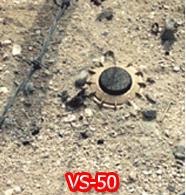INFO ONLY. GALLERY PICTURE. NOT FOR SALE P90-10
Specifications
* Weight: 185 g
* Explosive content: 43 g of RDX
* Diameter: 90 mm
* Height: 45 mm
* Operating pressure: 10 kg

The VS-50 is an Italian circular plastic cased anti-personnel blast mine. The mine was produced by Valsella Meccanotecnica SpA. The design is similar to the TS-50 and VS-MK2 mine. It is blast resistant and can be used in a minimum metal configuration. Though unlikely to kill, the explosive charge contained within a VS-50 is quite sufficient to destroy the victim's foot.
Description
The mine consists of three sections, a bottom section containing the main explosive charge, a middle section which contains the fuze and safety mechanism, and the top section which consists of a neoprene pressure pad. The neoprene pressure pad is sometimes reinforced with an 18 gram mild steel plate, which makes the mine detectable by metal detectors. The case is waterproof and can be used in water up to one metre deep. Most VS-50s were manufactured as minimal metal mines and are therefore much harder to detect.
The mine can be deployed by helicopters or ground vehicles or laid by hand. An electronically fuzed version of the mine, the VS-50AR with an integral mercury tilt switch anti-handling device was also produced. The VS-50AR looks very similar to the VS-50, which has obvious implications for mine clearance personnel. Generally, the render safe procedure for this mine is to blow in situ, or burn through the plastic casing using some form of special incendiary device.
Operation
A sustained downward force of approximately force of ten kilograms on the pressure plate for a minimum of 0.10 seconds compresses the firing spring and cocks the striker. Continuous downward movement allows the trigger assembly to pivot, slowly forcing the air out of an anti-shock bladder and flips the striker down into the stab sensitive detonator, at which point the mine explodes.
The air pressure delay mechanism effectively blocks detonation if the force on the pressure plate is short, since air does not have to leave the small anti-shock bladder. This has two direct applications, it allows the mine to be dropped from helicopter mine scattering systems, and it dramatically increases the mine's resistance to explosive based mine clearance techniques.
Countries used in
The mine has been encountered in Afghanistan, Angola, Ecuador, Iraq, Kurdistan, Kuwait, Lebanon, Peru, Rawanda, Sri Lanka, the Western Sahara, and Zimbabwe.